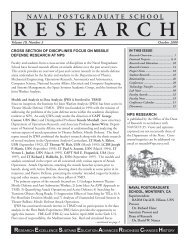Spectral Unmixing Applied to Desert Soils for the - Naval ...
Spectral Unmixing Applied to Desert Soils for the - Naval ...
Spectral Unmixing Applied to Desert Soils for the - Naval ...
You also want an ePaper? Increase the reach of your titles
YUMPU automatically turns print PDFs into web optimized ePapers that Google loves.
VII. DISCUSSION AND CONCLUSIONS<br />
A. SPECTRAL MEASUREMENTS AND SOIL DISTURBANCE<br />
Analysis of <strong>the</strong> collected spectral libraries established that <strong>the</strong>re were measurable<br />
differences between spectra of disturbed versus undisturbed areas of <strong>the</strong> same<br />
composition materials. Endmembers collected in <strong>the</strong> field were all categorized by a<br />
material first undisturbed and <strong>the</strong>n disturbed from <strong>the</strong> same location. The disturbances<br />
were all caused by impact-related use such as walking, driving over, or dropping<br />
something on<strong>to</strong> <strong>the</strong> soil, OHV and equestrian use (horses). Firerelated disturbances were<br />
also used in order <strong>to</strong> have in<strong>for</strong>mation regarding camp fires <strong>to</strong> help associate <strong>the</strong> source<br />
as anthropogenic. For <strong>the</strong> initial clay collection <strong>the</strong> samples were all taken from <strong>the</strong> same<br />
area and spanned a section of roughly 1.62 Km 2 . The continuum removed spectral<br />
differences occur in <strong>the</strong> wavelength regions of approximately 500 nm, 1200 nm, and<br />
2200 nm. The changes observed at <strong>the</strong>se wavelengths involve differences in apparent<br />
reflectance received at <strong>the</strong> sensor and calculated differences in band depth and observable<br />
width differences of absorption features in <strong>the</strong> same material. Similarities in <strong>the</strong> amount<br />
of difference in depths between ASD collected endmembers and imagery derived<br />
endmembers suggested that <strong>the</strong>se differences made <strong>the</strong> spectra unique enough <strong>to</strong> be<br />
successfully used <strong>to</strong> detect features such as trails based on differences in spectral<br />
characteristics.<br />
Clearly properties of soils are altered once <strong>the</strong>y have been exposed <strong>to</strong> some<br />
surface disturbance, particularly those caused by impacts. It is <strong>the</strong> chemical and<br />
structural make-up of soil that causes it <strong>to</strong> exhibit its characteristic absorption feature.<br />
Previous studies have found similar changes in reflectance and spectra shape, depth, and<br />
width of vegetation exposed <strong>to</strong> gasses injected in<strong>to</strong> soils. These changes were <strong>the</strong> result<br />
of a stress response by vegetation <strong>to</strong> <strong>the</strong> gasses as a function of distance from <strong>the</strong> source.<br />
It makes sense <strong>the</strong>n that if reflectance changes in vegetation are a response <strong>to</strong> an<br />
ecosystem disturbance, <strong>the</strong>n <strong>the</strong> reflectance changes in this study can be correlated <strong>to</strong><br />
anthropogenically caused surface disturbances as well. The data shown in this report<br />
support this line of thinking because <strong>the</strong> changes in reflectance are similar enough <strong>to</strong> <strong>the</strong><br />
75
















